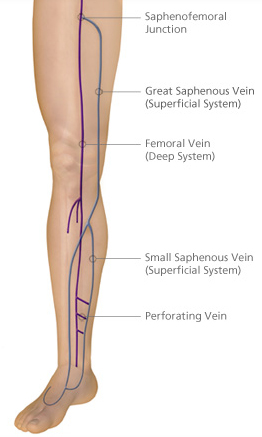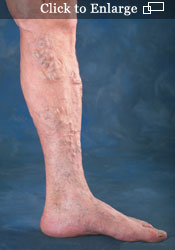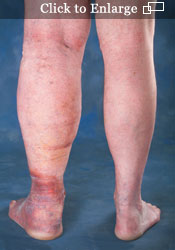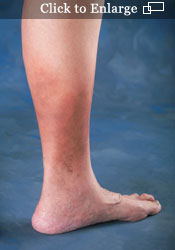Vein Treatment
As the premier Las Vegas Vein Treatment Center, we strive to provide you with the best options available for your particular vein care needs. Using state-of-the-art equipment, knowledge and experience, we can help you achieve the pain-free confidence you deserve.Because every patient is different, we understand the importance of your individual concerns. We will design a custom treatment that suits your specific needs.
Understanding Superficial Venous Reflux
Veins serve as pathways through which deoxygenated blood travels from the body back to the heart. There are three types of veins in the legs: superficial, deep and perforating. The network of superficial veins located near the surface of the skin is known as the saphenous vein. Deep veins are large veins found in between the muscles. Perforating veins act as bridges, carrying blood from the saphenous vein to the deep veins of the leg. Each type of vein plays an important role in the function of the body’s circulatory system.
Veins contain tiny valves, the function of which is to ensure the deoxygenated blood continuously flows in the correct direction: toward the pumping heart. Normally, these valves open and close rhythmically, which prevents the backflow of blood into the leg.
When the superficial veins become damaged or diseased, the valves within fail to function properly, causing the vein to become congested with poorly circulated blood – this condition is referred to as superficial venous reflux. Also known as saphenofemoral reflux, superficial venous reflux often leads toward a progression of symptoms, including varicose veins.
Venous Reflux Disease Symptoms
Spider veins are small blue or red lines that appear close to the surface of the skin. They can look like thin lines, branching trees or spider webs. Appearing on not only the legs, but also often around the nose and lips, spider veins are rarely painful. Spider veins are not harmful, but they can be unsightly, so patients often choose to have them removed for cosmetic reasons.


Varicose Veins
Varicose veins are snake-like, swollen veins that occur on the surface of the skin. Often painful, varicose veins can be located anywhere on the body, but are most typically found in the legs and feet. Often these damaged veins cause throbbing, aching and/or burning pain, swelling, itching and heaviness of the leg. Varicose veins are progressive, and will get worse if left untreated.
Untreated vein diseases can lead to a variety of serious conditions:
Edema (Leg Swelling)
If varicose veins are not treated in a timely manner, the damaged valves will continue to function improperly, allowing blood and fluid to pool in the leg. The leg and ankle can swell, sometimes extremely, causing severe discomfort and unsightliness.


Skin Changes
Venous reflux disease causes venous hypertension (higher than normal venous blood pressure). Due to this increased pressure, fluids and blood are often pushed toward the skin’s surface. This can result in changes in skin texture and skin color (hyperpigmentation).
Venous Ulcers
Severe and painful, venous ulcers occur when inadequate circulation causes the vein to leak, destroying the surface of the skin. This creates an open, weeping wound, subject to infection. These sores, commonly found near the ankle, can take months or even years to heal if venous reflux is left untreated.
Click on the 30 second video-clip to learn more about venous reflux

